Input interpretation

benzoic acid
Chemical names and formulas
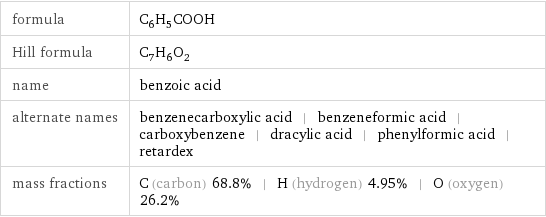
formula | C_6H_5COOH Hill formula | C_7H_6O_2 name | benzoic acid alternate names | benzenecarboxylic acid | benzeneformic acid | carboxybenzene | dracylic acid | phenylformic acid | retardex mass fractions | C (carbon) 68.8% | H (hydrogen) 4.95% | O (oxygen) 26.2%
Lewis structure
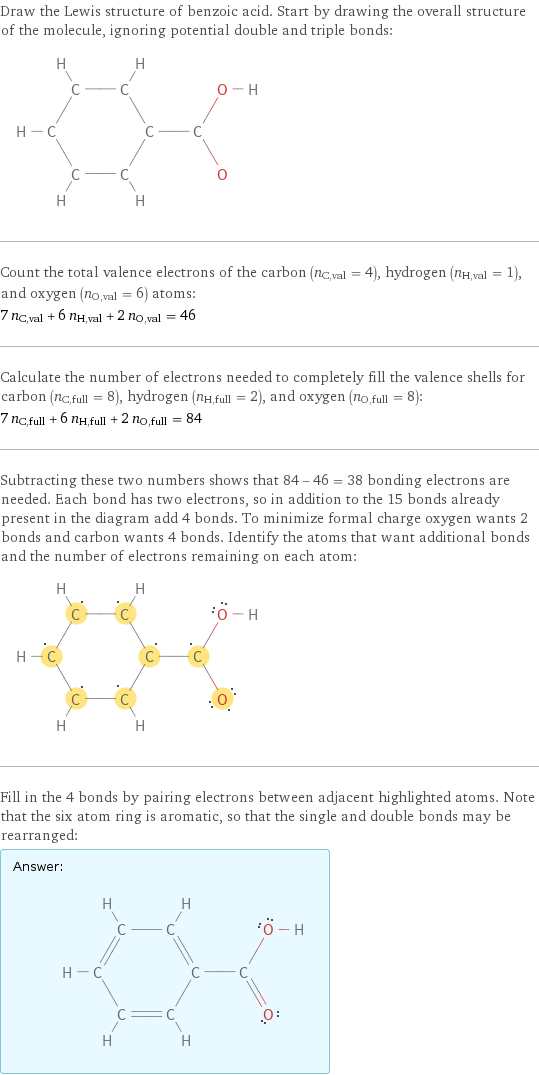
Draw the Lewis structure of benzoic acid. Start by drawing the overall structure of the molecule, ignoring potential double and triple bonds: Count the total valence electrons of the carbon (n_C, val = 4), hydrogen (n_H, val = 1), and oxygen (n_O, val = 6) atoms: 7 n_C, val + 6 n_H, val + 2 n_O, val = 46 Calculate the number of electrons needed to completely fill the valence shells for carbon (n_C, full = 8), hydrogen (n_H, full = 2), and oxygen (n_O, full = 8): 7 n_C, full + 6 n_H, full + 2 n_O, full = 84 Subtracting these two numbers shows that 84 - 46 = 38 bonding electrons are needed. Each bond has two electrons, so in addition to the 15 bonds already present in the diagram add 4 bonds. To minimize formal charge oxygen wants 2 bonds and carbon wants 4 bonds. Identify the atoms that want additional bonds and the number of electrons remaining on each atom: Fill in the 4 bonds by pairing electrons between adjacent highlighted atoms. Note that the six atom ring is aromatic, so that the single and double bonds may be rearranged: Answer: | |
3D structure
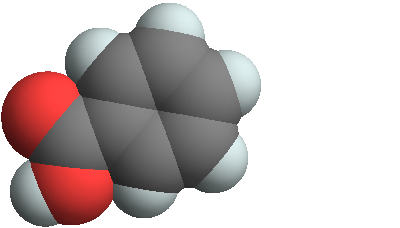
3D structure
Basic properties
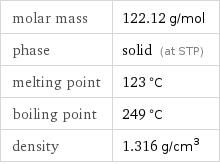
molar mass | 122.12 g/mol phase | solid (at STP) melting point | 123 °C boiling point | 249 °C density | 1.316 g/cm^3
Units

Hydrophobicity and permeability properties
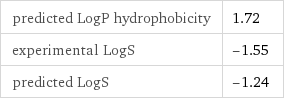
predicted LogP hydrophobicity | 1.72 experimental LogS | -1.55 predicted LogS | -1.24
Basic drug properties

approval status | experimental | small molecule drug categories | food preservative
Solid properties (at STP)

density | 1.316 g/cm^3 vapor pressure | 9.998 mmHg refractive index | 1.504
Units

Thermodynamic properties

specific heat capacity c_p | solid | 1.202 J/(g K) molar heat capacity c_p | solid | 146.8 J/(mol K) specific heat of formation Δ_fH° | gas | -2.407 kJ/g | solid | -3.154 kJ/g molar heat of formation Δ_fH° | gas | -294 kJ/mol | solid | -385.2 kJ/mol molar heat of vaporization | 65.4 kJ/mol | specific heat of vaporization | 0.536 kJ/g | molar heat of combustion | 3229 kJ/mol | specific heat of combustion | 26.44 kJ/g | molar heat of fusion | 18.02 kJ/mol | specific heat of fusion | 0.1476 kJ/g | critical temperature | 752 K | critical pressure | 4.6 MPa | (at STP)
Chemical identifiers
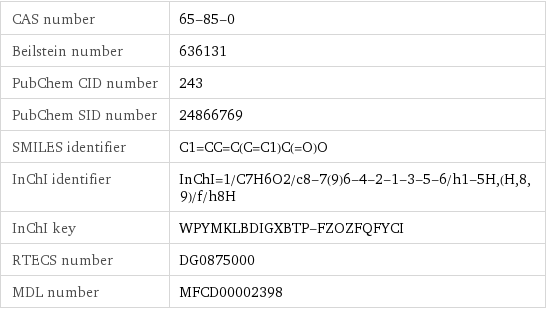
CAS number | 65-85-0 Beilstein number | 636131 PubChem CID number | 243 PubChem SID number | 24866769 SMILES identifier | C1=CC=C(C=C1)C(=O)O InChI identifier | InChI=1/C7H6O2/c8-7(9)6-4-2-1-3-5-6/h1-5H, (H, 8, 9)/f/h8H InChI key | WPYMKLBDIGXBTP-FZOZFQFYCI RTECS number | DG0875000 MDL number | MFCD00002398
NFPA label

NFPA label
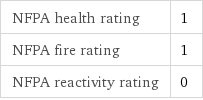
NFPA health rating | 1 NFPA fire rating | 1 NFPA reactivity rating | 0
Safety properties
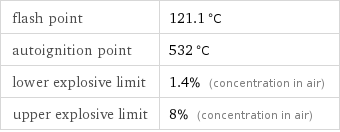
flash point | 121.1 °C autoignition point | 532 °C lower explosive limit | 1.4% (concentration in air) upper explosive limit | 8% (concentration in air)

DOT hazard class | 6.1 DOT numbers | 9094
Toxicity properties

RTECS classes | agricultural chemical and pesticide | mutagen | human data | primary irritant